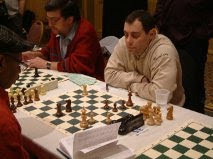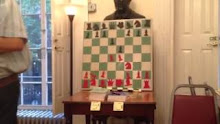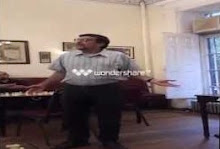However, a significant improvement for Black is the theoretical novelty 12...Qc7!, sacrificing the c5 pawn for dynamic play. My game as Black against Herb Hickman in the 1986 West Orange Club Championship continued 13.Nxc5 Nb4! 14.Na4 Rfd8 15.Bd4 b5 16.cxb5 axb5 17.Nc5 e5 18.Qd2? Qxc5!, winning a piece.
If White had tried 18.a3, then 18...exd4 19.axb4 dxe3 20.Na6 exf2+ would have left Black with a big advantage.
Another sharp line would have occurred if, instead of walking into the pin with 15.Bd4, White had played 15.Qc1. I was prepared to follow with 15...Nd3 16.Qc3 b5 17.cxb5 Qxc3 18.Bxc3 axb5 19.Nb2 Nxb2 20.Bxb2 Rd2 21.Bxf6 Bxf6 22.Rae1 Bd3 23.Bf3 Rxa2, again with a tremendous advantage for the second player.
Or 22.Nd4 Bxd4 23.exd4 Rxd4 with a good game for Black. For example, 24.a4 Bc2 25.a5 Bxb3 26.a6 Bd5 27.a7 Ra8.
The critical variation after 13...Nb4 is 14.e4. Now, if nothing else, Black could regain the pawn via 14...Qxc5 15.exf5 Qxf5.
But more in the spirit of the position would be 14...Bg4 15.f3 Rfd8 with tactical complications that do not disfavor Black.
Of course, Black could have avoided this line entirely by playing Watson's recommended 10...Qa5 and only then 11...a6. However, it is not clear that Black's queen belongs on a5 since in effect he is playing a variation for White one tempo down which can well be answered by 11.Qd2 and 12.Rfd1.
After the immediate 10...a6, White does better to avoid Watson's 11.dxc5 which only opens the d-file to Black's king rook. But this also allows Black the option of developing his queen to c8, threatening the standard ...Bh3. For example, on 11.Qd2 Qc8 12.Rfe1 (to answer 12...Bh3 with 13.Bh1), we have reached by transposition my game against the same opponent from the 1985 Mel Benson Memorial. The game proceeded 12...b5 13.cxb5 axb5 14.dxc5 dxc5 15.Rad1 Ne5 16.e4 Bg4 17.Qe3 c4 with double-edged play (draw in 34 moves).
{This article originally appeared in Atlantic Chess News in 1986}




























